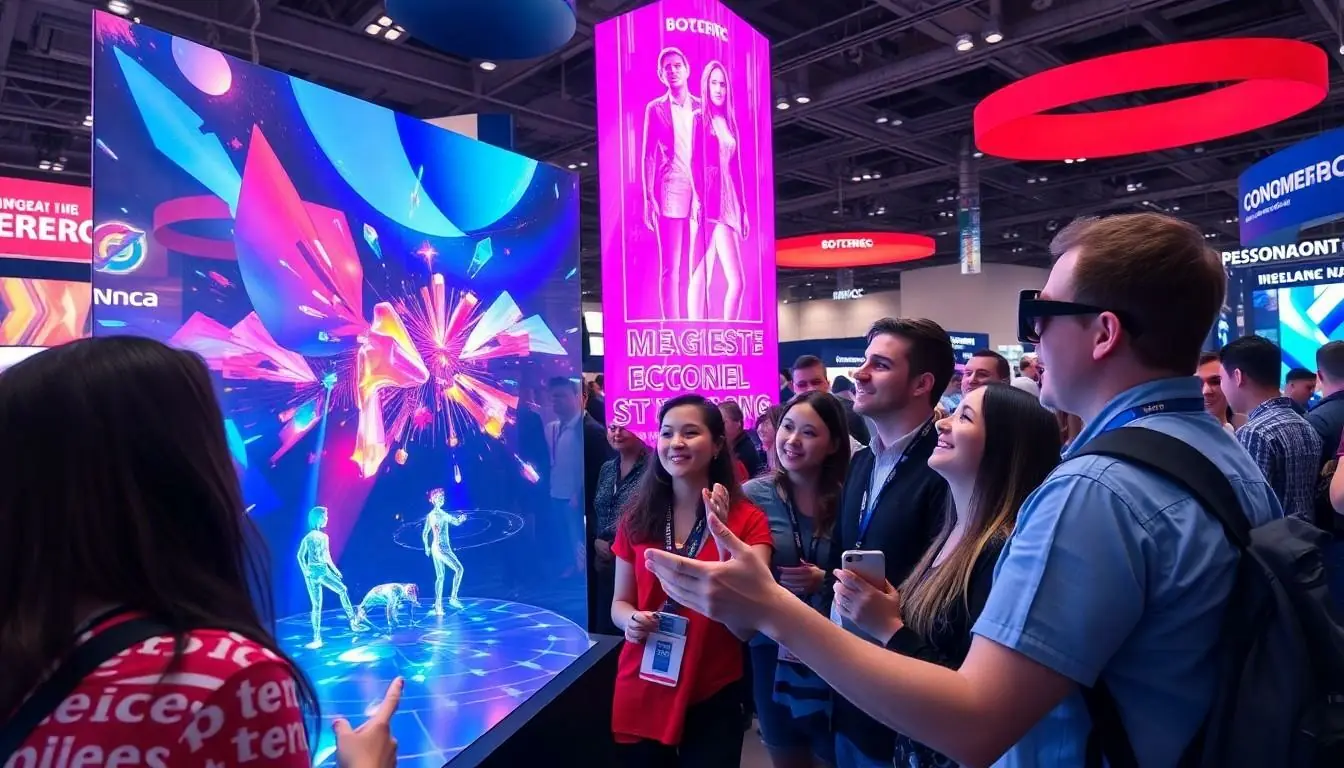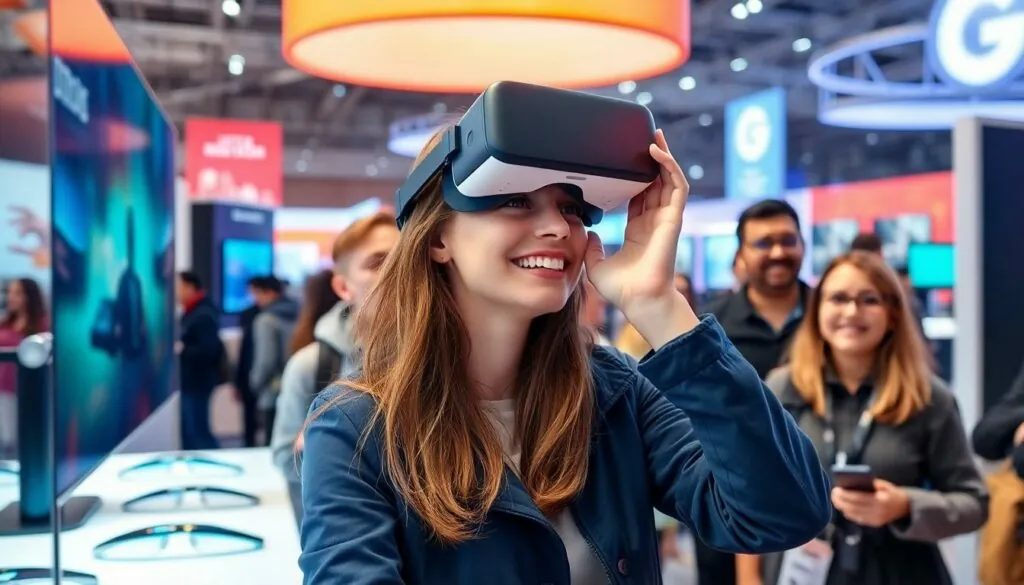The Consumer Electronics Show (CES) isn’t just about gadgets; it’s a playground for marketers looking to create unforgettable experiences. Imagine walking through a maze of cutting-edge tech, where every booth is a chance to wow attendees and leave a lasting impression. It’s where the latest innovations meet creative storytelling, and brands can turn casual onlookers into loyal fans with just a spark of imagination.
Table of Contents
ToggleOverview of Consumer Electronics Show Experience Marketing
Experience marketing at the Consumer Electronics Show (CES) emphasizes interaction and engagement. Brands create immersive experiences that captivate attendees, moving beyond traditional advertising. Innovative displays and hands-on demonstrations invite visitors to explore products firsthand, generating excitement and fostering brand loyalty.
CES serves as a dynamic stage for tech companies. Each year, thousands of participants witness sophisticated launches and unique presentations. These experiences showcase advanced features, encouraging consumers to connect emotionally with products. Experiences turn passive viewers into active participants, enhancing brand perception.
Interactive elements play a crucial role in effective experience marketing. Gamification, virtual reality, and augmented reality engage users on multiple levels. Attendees often share experiences on social media, amplifying brand visibility beyond the event. Creating hashtag campaigns or contests generates buzz and encourages user participation.
Storytelling further enriches the experience. Brands present narratives that resonate with audiences, illustrating product benefits effectively. Highlighting personal stories or customer journeys reinforces authenticity, making connections with potential buyers stronger. Successful storytelling captivates and motivates attendees to talk about brands long after the event.
Data collected during CES supports marketers in evaluating their strategies. Metrics on visitor interactions and engagement levels help assess overall effectiveness. Analyzing this data allows brands to refine their marketing approaches for future events. Experience marketing at CES remains a pivotal strategy for attracting and retaining customers in an increasingly competitive marketplace.
Importance of Experience Marketing in Consumer Electronics

Experience marketing stands out at the Consumer Electronics Show (CES) for its capacity to engage attendees meaningfully. It transforms traditional interactions into memorable experiences that drive customer engagement.
Engaging the Audience
Capturing audience attention remains essential for brands at CES. Interactive displays showcase cutting-edge technology while inviting hands-on participation. Live demonstrations highlight product capabilities, making them relatable to consumers. Gamification elements stimulate excitement, encouraging visitors to immerse themselves fully. Virtual reality setups transport attendees to new worlds, reinforcing product relevance. Augmented reality experiences enhance the storytelling aspect, helping attendees visualize products in their environments. Emotional connections form as audiences engage with brands in a memorable way, fostering stronger relationships.
Building Brand Loyalty
Establishing brand loyalty requires consistent interaction and memorable experiences. Unique activations create lasting impressions that encourage return visits. Sharing personal narratives helps humanize products, fostering relatability and trust. As consumers form emotional ties with brands, loyalty increases significantly. CES serves as an ideal platform to showcase innovation while aligning brand values with consumer expectations. Post-event engagement strategies, such as follow-up communications, keep the connection alive, further solidifying brand loyalty. Continuous interaction plays a crucial role in transforming casual visitors into brand advocates, contributing to long-term success.
Key Strategies for Effective Experience Marketing
Experience marketing at CES focuses on creating memorable interactions. Engaging attendees through innovative strategies enhances brand visibility and loyalty.
Interactive Displays
Interactive displays captivate attendees by encouraging hands-on participation. Brands use touchscreen technology to allow visitors to explore product features. These dynamic exhibits enhance user engagement while promoting brand stories effectively. Simple yet impactful design elements draw people in, making them feel part of the experience. Feedback mechanisms, such as quick surveys, help brands gather insights for future innovations.
Virtual and Augmented Reality Integration
Virtual reality and augmented reality provide immersive experiences that transport attendees into different worlds. VR headsets let users engage with products in simulated environments, showcasing their potential. Augmented reality overlays digital information onto physical objects, enhancing understanding and interest. This technology invites attendees to explore products interactively, creating lasting impressions. Brands leveraging these tools stand out, as they offer unique experiences that traditional marketing misses.
Notable Examples from Recent Shows
Recent Consumer Electronics Shows featured innovative approaches that captured attention and drove consumer engagement.
Successful Brands and Innovations
Several brands stood out with their impactful activations. Samsung amazed attendees with its interactive Smart Home display, showcasing connected appliances that adapted to users’ needs. LG presented its transparent OLED displays, blending aesthetics with functionality. Sony utilized augmented reality for immersive gaming experiences, allowing participants to engage with products dynamically. Honda’s robotics presentation captivated audiences, highlighting the future of mobility and technology synergy. Each activation not only showcased products but also encouraged hands-on interaction, increasing attendee involvement.
Consumer Reactions and Feedback
Attendee reactions varied, but enthusiasm dominated. Many participants expressed satisfaction with the interactive elements, citing personalized experiences that felt engaging. Feedback indicated a strong preference for immersive technology, specifically virtual and augmented reality applications. Surveys revealed that 80% of visitors valued experiences over traditional promotions. Moreover, social media buzz increased significantly, with attendees sharing their experiences widely online. This indicates that brands utilizing experience marketing strategies at CES effectively fostered lasting impressions and connections with consumers.
Future Trends in Experience Marketing
Experience marketing continues to evolve, shaped by emerging technologies and shifting consumer preferences. Organizations increasingly focus on engaging consumers through innovative strategies.
Technological Advancements
Advanced technology drives experience marketing into new territories. Brands leverage virtual reality to immerse consumers in experiences unlike any other. Augmented reality enhances product interaction through engaging overlays that complement physical objects. Gamification elements are implemented to motivate participation and create memorable experiences. Real-time data collection allows marketers to tailor strategies on the fly, optimizing consumer engagement. Wearable tech offers insights into participant behavior, enabling brands to refine their activations effectively. The integration of artificial intelligence enhances personalization, delivering tailored content and interactions that resonate deeply with users.
Shifts in Consumer Behavior
Consumers display a growing preference for experiences over traditional advertising. Engaged audiences prioritize participation and immersion when evaluating brand interactions. Research shows that 80% of attendees at CES prefer experiences enriched by technology. Emotional responses play a key role in these interactions, fostering deeper connections with brands. As convenience becomes a priority, consumers gravitate towards accessible digital experiences. Social sharing amplifies the desire for sharing unique experiences with peers. This trend emphasizes the need for brands to create unique, authentic interactions that resonate with customers on a personal level. Marketers must adapt swiftly to evolving preferences to maintain relevance in this competitive landscape.
The Consumer Electronics Show serves as a dynamic stage for brands to redefine their marketing strategies through experience. By harnessing innovative technologies and interactive storytelling, companies can create memorable moments that resonate deeply with audiences.
As consumer preferences shift towards immersive experiences, brands that effectively engage attendees stand to gain loyalty and trust. The emphasis on emotional connections and personalized interactions will continue to shape the future of marketing.
With each CES, the potential for brands to captivate and inspire grows, making experience marketing an essential component in today’s competitive landscape. Embracing these strategies not only enhances visibility but also fosters enduring relationships with consumers.




